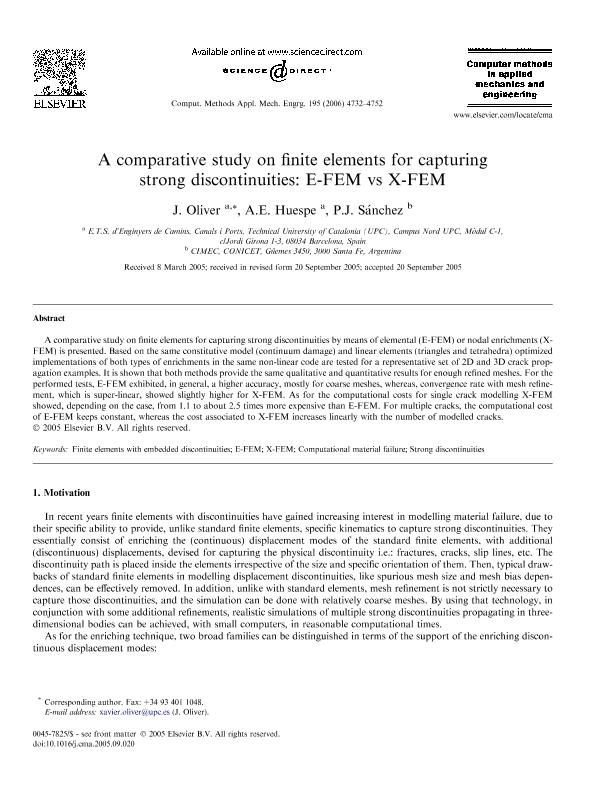Mostrar el registro sencillo del ítem
dc.contributor.author
Oliver, J.
dc.contributor.author
Huespe, Alfredo Edmundo

dc.contributor.author
Sánchez, Pablo Javier

dc.date.available
2017-10-10T16:33:14Z
dc.date.issued
2006-12
dc.identifier.citation
Oliver, J.; Huespe, Alfredo Edmundo; Sánchez, Pablo Javier; A comparative study on finite elements for capturing strong discontinuities: E-FEM vs X-FEM; Elsevier Science Sa; Computer Methods in Applied Mechanics and Engineering; 195; 37-40; 12-2006; 4732-4752
dc.identifier.issn
0045-7825
dc.identifier.uri
http://hdl.handle.net/11336/26356
dc.description.abstract
A comparative study on finite elements for capturing strong discontinuities by means of elemental (E-FEM) or nodal enrichments (XFEM) is presented. Based on the same constitutive model (continuum damage) and linear elements (triangles and tetrahedra) optimized implementations of both types of enrichments in the same non-linear code are tested for a representative set of 2D and 3D crack propagation examples. It is shown that both methods provide the same qualitative and quantitative results for enough refined meshes. For the performed tests, E-FEM exhibited, in general, a higher accuracy, mostly for coarse meshes, whereas, convergence rate with mesh refinement, which is super-linear, showed slightly higher for X-FEM. As for the computational costs for single crack modelling X-FEM showed, depending on the case, from 1.1 to about 2.5 times more expensive than E-FEM. For multiple cracks, the computational cost of E-FEM keeps constant, whereas the cost associated to X-FEM increases linearly with the number of modelled cracks.
dc.format
application/pdf
dc.language.iso
eng
dc.publisher
Elsevier Science Sa

dc.rights
info:eu-repo/semantics/openAccess
dc.rights.uri
https://creativecommons.org/licenses/by-nc-sa/2.5/ar/
dc.subject
Finite Elements with Embedded Discontinuities
dc.subject
E-Fem
dc.subject
X-Fem
dc.subject
Computational Material Failure
dc.subject
Strong Discontinuities
dc.title
A comparative study on finite elements for capturing strong discontinuities: E-FEM vs X-FEM
dc.type
info:eu-repo/semantics/article
dc.type
info:ar-repo/semantics/artículo
dc.type
info:eu-repo/semantics/publishedVersion
dc.date.updated
2017-10-09T16:53:32Z
dc.journal.volume
195
dc.journal.number
37-40
dc.journal.pagination
4732-4752
dc.journal.pais
Países Bajos

dc.journal.ciudad
Amsterdam
dc.description.fil
Fil: Oliver, J.. Universidad Politecnica de Catalunya; España
dc.description.fil
Fil: Huespe, Alfredo Edmundo. Consejo Nacional de Investigaciones Científicas y Técnicas. Centro Científico Tecnológico Conicet - Santa Fe. Instituto de Desarrollo Tecnológico para la Industria Química. Universidad Nacional del Litoral. Instituto de Desarrollo Tecnológico para la Industria Química; Argentina. Universidad Politecnica de Catalunya; España
dc.description.fil
Fil: Sánchez, Pablo Javier. Consejo Nacional de Investigaciones Científicas y Técnicas. Centro Científico Tecnológico Conicet - Santa Fe. Instituto de Desarrollo Tecnológico para la Industria Química. Universidad Nacional del Litoral. Instituto de Desarrollo Tecnológico para la Industria Química; Argentina
dc.journal.title
Computer Methods in Applied Mechanics and Engineering

dc.relation.alternativeid
info:eu-repo/semantics/altIdentifier/doi/http://dx.doi.org/10.1016/j.cma.2005.09.020
dc.relation.alternativeid
info:eu-repo/semantics/altIdentifier/url/http://www.sciencedirect.com/science/article/pii/S0045782505005049
Archivos asociados
